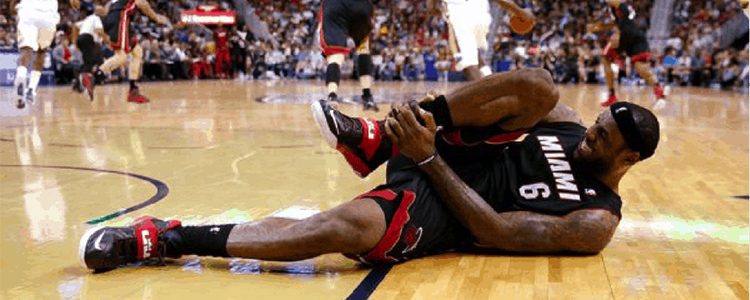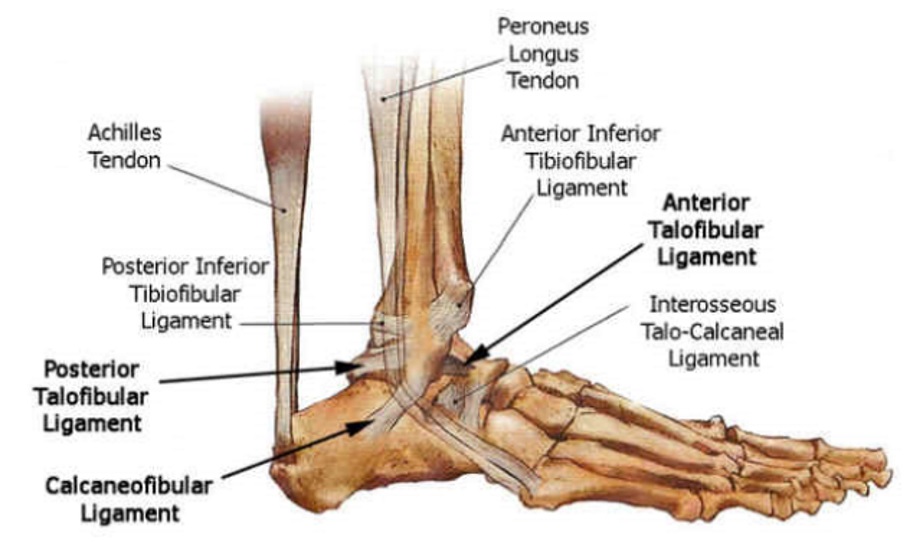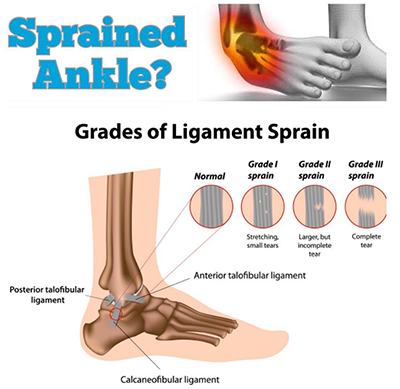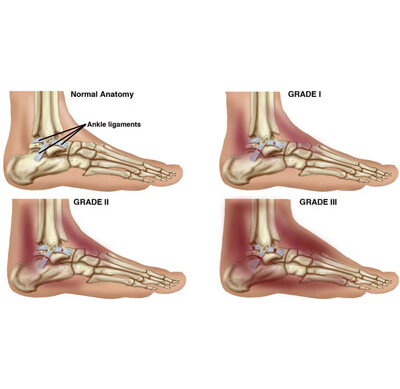Ankle Sprains: The Real Story

Ankle sprains are one of the most common injuries in our society today.
It is safe to say that anyone who has played a sport, recreationally or competitively, has rolled their ankle in some sort of fashion. For many, the result is some soreness, maybe a little swelling, on the outside of the ankle that slowly resolves over a few days to a week. However, this is only part of the story about ankle sprains! Some ankle sprains are so severe that they require up to 3 months to heal and some even result in reconstructive surgery! Today we would like to describe the different levels of ankle sprains and what to expect when going through the healing process.
Ankle sprains occur when someone lands on their ankle awkwardly forcing the ankle to roll inwards forcefully (Inversion Sprain). This results in stretching and tearing of up to 3 ligaments on the outside of the ankle. The image below highlights the 3 major lateral ankle structures that resist forceful inversion of the ankle or rolling inward.

The severity of the sprain depends on how many of the 3 ligaments are damaged and how severely the ligaments are stretched or torn. This will determine how long it will take to recover and rehabilitate before safe return to activity can be achieved. Ankle sprains are typically graded as Grade I (mild), Grade II (Moderate), or Grade III (severe). The following images illustrate how the ligaments are damaged with each degree of severity as well as swelling and ecchymosis (bruising) that typically occurs with each degree of ankle sprain.


Grade I Ankle Sprains
Grade I Ankle Sprains are characterized by mild pain and soreness on the outside of the ankle, mild swelling that may last for a few days, and minimal ecchymosis (bruising). Total healing time usually takes 1-2 weeks with a rapid return to full activity within 2 weeks. Treatment mainly focuses on icing the ankle a couple times per day, gradually stretching and moving the ankle around, followed by some proprioceptive (balance) exercises before returning to full activity when comfortable. A couple of formal physical therapy visits may be appropriate to progress the program safely and efficiently.
Grade II Ankle Sprains
Grade II Ankle Sprains are characterized by moderate to severe pain on the outside of the ankle, significant swelling over the outside of the ankle (may look like a small orange over the outside ankle bone), and moderate ecchymosis (bruising) that will go from the outside of the ankle down to the outside and top of the foot sometimes running out to the toes. As you can see from the images above, a Grade II ankle sprain represents some partial tearing of the ligaments. Crutches and a stabilizing ankle brace may be required for a couple weeks as a gradual progress to full weight bearing is made. It is extremely important to ice the swollen ankle regularly several times per day until pain and swelling has subsided. Physical Therapy is often indicated within a few days of the injury so modalities such as electrical stimulation, ice, and edema reducing efflourage techniques can be initiated. As the ankle heals, ROM and strengthening exercises are added and progressed to help the subject return to running and full sports activity safely over a 4-6 week period.
Grade III Ankle Sprains
Grade III Ankle Sprains represent the worst-case scenario here as there is severe pain globally around the ankle and severe swelling quickly making the ankle look like a grapefruit. There is also severe and global bruising that will often go up the lateral ankle engulfing the entire lateral ankle, foot, toes, and even into the arch of the foot. Oftentimes, putting weight on the foot and ankle will be impossible for several days or even a couple weeks. These types of sprains typically require some immobilization in a cast or walking boot for several weeks to securely protect the healing ligaments and other soft tissue structures. X-rays will be indicated to make sure there was not a fracture as well. Formal Physical Therapy is started once the cast has been removed, about 4 weeks post-injury. Treatment will include consistent icing and elevation (to reduce swelling) and a gradual re-introduction of ROM and light strengthening exercises. This will be followed by a gradual increase in strengthening and proprioception (balance) exercises until the ankle is ready to take on the stress of running and other cutting types of activities. It typically takes 12+ weeks to return to full activity following a Grade III ankle sprain. In some cases, structural stability may not reach acceptable levels to return to sport or activity in which case surgical options may need to be considered!
As you can see having an ankle sprain can be confusing and difficult to safely recover from. If you or someone you know “rolls their ankle”, we would recommend getting a quick x-ray especially if symptoms indicate a Grade II or more sprain to rule out any fractures.
